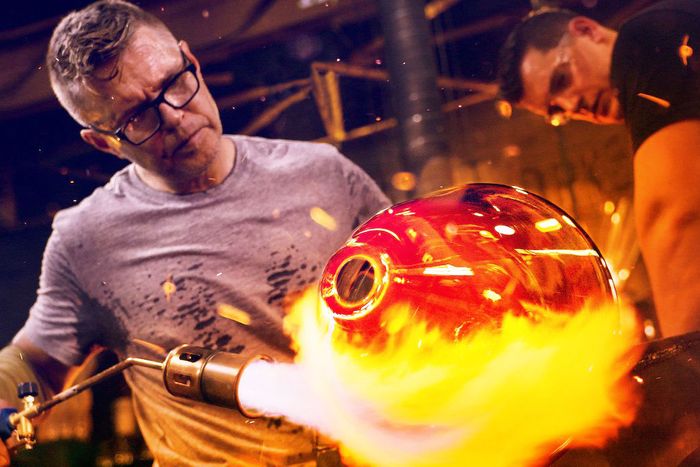
Over the years, the reality competition genre has explored many skill sets. There have been shows about cooking, baking, singing, survivalism, fashion design, dancing, modeling, doing drag, global trekking, more baking, obstacle-course completion, crafting, entrepreneurship, makeup artistry, and bad baking. At this point, it seems like this category of television may have run out of specialties to focus on.
But this summer, two new shows have proved that there is still new terrain for reality competition shows to explore. One of those is about extreme miniature golf; the other is about glass blowing. The latter takes its craft very seriously; the former could not take itself less seriously unless all the hosts and competitors decided to do an entire episode standing on their heads, which, quite frankly, seems like a thing that could happen.
The glassblowing series is called Blown Away, and its ten episodes dropped on Netflix earlier this month. The mini-golf show is Holey Moley, and its ten-episode season started airing Thursday nights on ABC in June. The two shows are different in approach, sensibility, and basic attitudes, yet both are ideal summer TV programming. In different ways, watching each one is like taking a mini-vacation.
Let’s start with Holey Moley, a show created by producer Chris Culvenor, presumably after he got high while perfecting his short-putt game and watching American Ninja Warrior. Holey Moley combines the obstacle-course features of Ninja Warrior — or, more accurately, the defunct ABC series Wipeout — with mini-golf, resulting in holes that have classic mini-golf obstacles but also zip lines and rolling logs that could knock a less-than-alert golfer out cold.
One of Holey Moley’s executive producers is Steph Curry, who appears a couple of times in every episode to drive a golf ball and do a brief, unnecessary interstitial comedy bit. Monday Night Football broadcaster Joe Tessitore and actor Rob Riggle act as the hosts and color commentators.
“Yes, this is literally a mini-golf competition,” Riggle announced at the beginning of the first episode. “And yes, it’s on prime time with an absurd budget.”
Absurdity is at the center of Holey Moley’s code of conduct. Its contestants, who play elimination holes until a new weekly Holey Moley champion is crowned, have apparently been told by producers to wear the most embarrassing outfits imaginable — which is why one competitor came dressed in a unicorn onesie (“I am the Kobe Bryant of golf,” he declared; reader, he was not) and others have made a sport out of wearing ridiculous trousers. Contestants have strutted around the greens in banana pants, court-jester pants, leopard-print pants, and, on two occasions, American-flag pants. It turned out the American-flag-pants-wearers were brothers. A pair of siblings getting to compete within the first four episodes of Holey Moley suggests the rules on this show are lax at best. As an added bonus, the brothers also happened to be a pair of showboating tools. Brother No. 2, Michael Glauser, who competed in episode four, even made up his own insufferable catchphrase, which is, and I really do quote, “I’m the guy, dude.”
“It’s hard to know which Glauser brother irritated me the least,” Riggle remarked during that episode. Same here, Rob Riggle. (In case this isn’t already clear: At least one contestant in every episode of Holey Moley could credibly pass as a not at all distant cousin of Steve Stifler from American Pie.)
The real fun of Holey Moley is watching the golfers — some of whom have competed professionally — take on such utterly wild holes, like Dutch Courage, which features two oversize windmills that golfers must putt through, then dash through themselves without getting smacked by a rapidly rotating blade. (Some golfers have been assaulted by those windmills; I assume the liability waivers everyone signs before competing are extremely detailed.) Then there’s the Arc de Trigolf, which involves putting up a 15-foot ramp and dashing across a water obstacle in time to shut down a guillotine that prevents your ball from falling into a water hazard. And the Distractor, a straightforward hole that involves a single long putt but makes putting impossible by introducing a massive distraction: So far, those have included Kenny G playing his sax, an Army drill sergeant who screams in golfers’ faces, and a pair of contortionists.
It’s all extremely silly, diverting fun. My only complaint about Holey Moley is that the formula starts to feel a little redundant. I realize that designing and constructing all the holes featured on the show were probably expensive and undoubtedly time-consuming, but after a few episodes, I wanted to see new holes. I guess that’s what happens when you get a taste of Holey Moley: You immediately want more. Extreme mini-golf, man. It’s a helluva drug.
On Blown Away, however, literally everything seems new. Unlike miniature golf, which most people have probably played at least once, the specifics of glassblowing will likely be foreign to most viewers. They certainly were to me.
Hence, not only do we get to meet the ten artists who will either advance or be eliminated over the course of the season, we also get introduced to the glassblowing process, which has its own tools, techniques, and vocabulary. Annealer is a word I’ve never used nor heard in my life until I watched Blown Away. (For the record, it’s sort of like a slow fridge that cools down glass artworks in a way that won’t shatter or damage them.) Punty is another thing I’d never said before. (It’s the metal rod used in glassblowing). I was familiar with the term glory hole, but, um, not in a glassblowing context. (In that world, it’s a hole in the side of a furnace that enables an artist to uniformly reheat and reshape the glass they’re working on.) Amazingly, no one at any point in Blown Away acknowledges that glory hole is also a sexual slang term.
Clearly, Blown Away takes the work at hand seriously, even though that work is presented in a light, accessible way. In other words, no one on this show shows up wearing American-flag pants. Host Nick Uhas, a former contestant on Big Brother, and Professor Katherine Grey, the show’s resident artist and reviewer, play their roles straight. (In the movie version of Blown Away, Grey should absolutely be portrayed by Sigourney Weaver. What, you don’t think Hollywood will eventually resort to remaking reality shows as scripted motion pictures? Please. So naïve.)
Among the competitors — who complete different challenges in each episode in an effort to win $60,000 and a residency at the Corning Museum of Glass — there aren’t a lot of big, made-for-reality-TV personalities, either. Which is kind of refreshing. The closest Blown Away gets is Deborah, an experienced glass artist who brings a feminist point of view to her work and announces in the first episode, “I think I’m a very polarizing person.” Polarizing, you say? Deborah, you have come to the right genre.
The real star of the show is the glassblowing process, which is fascinating to watch. The way the artists spin and pull molten glass, tap their punty to remove each piece from it, and snip at sections of their not yet hardened sculptures has an almost ASMR quality. It’s, as the kids would say, very satisfying. The labor involved in doing all that work also gets pretty physical: There’s a lot of sweating and literal throwing of one’s back into it. Honestly, I got more tired watching the Blown Away contestants than I did observing anyone on Holey Moley.
There’s something vaguely inspiring in both of these shows, though. On Blown Away and, as ridiculous as it is, Holy Moley, the competitors deserve credit for putting themselves out there. Whether they’re holding a putter or a punty, they’re investing effort in something in a very public way and taking a risk. And they’re doing it to entertain those of us sitting at home, watching them do things while we do nothing at all. Like I said, these two programs are what summer TV is all about.



